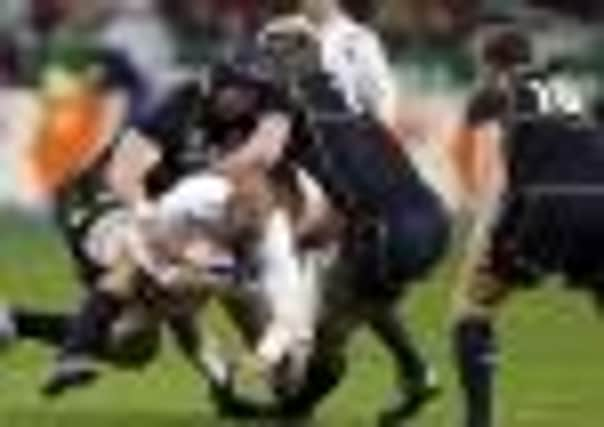Six Nations: Lack of ball carriers hampers Scots


There were three moments in this match where the crowd made themselves heard over and above the usual hullabaloo of an international Test. The first came around the 30-minute mark when strains of Flower of Scotland could be heard wafting over, appropriately enough, from the North Stand. The tartan-clad supporters had seen their team survive an eight-minute onslaught, both Benjamin Kayser and Wesley Fofana were held up over the line, and they assumed the worse was over. It was only beginning.
Secondly, the crowd greeted the half-time whistle, when France were trailing 6-0, with a wall of their own whistles to signify their continued disquiet with Les Bleus. Finally, they offered Freddy Michalak a rousing cheer as he limped from the field ten minutes from time, seemingly oblivious to the fact that, if the little Toulon scrum-half really is the best stand-off in France then French rugby can pack its bags and say “au revoir” right now.
Advertisement
Hide AdAdvertisement
Hide AdFor all the foreigners in the French Top 14, and South African-born flanker Antonie Claassen proved on Saturday that they can been a blessing as well as a curse, Philippe Saint-Andre still has an embarrassment of riches to choose from, which is not a claim anyone is making about the Scotland coach.
Scott Johnson badly needed everyone fit and raring to go but, instead, when he went to the locker stamped “Number Sevens” he found it the same situation as Old Mother Hubbard’s cupboard. Injuries to Ross Rennie, Chris Fusaro and John Barclay meant that Scotland played this tournament without a specialist openside, although the latter was up and running well before the end.
Wales fielded a brace of sevens on Saturday and Justin Tipuric walked away with the man of the match award. Both he and Sam Warburton will travel to Australia with the Lions.
Scotland’s exciting back three were stymied from the off since a classic outside centre is the man who traditionally tees them up, the man who loads the gun that the speedsters fire.
But Scotland played every Test with Sean Lamont sporting that No 13 shirt. It was primarily a defensive move because Lamont is primarily a defensive player. Just like Rob Harley, he was there to stop the opposition from playing rather than to to enhance Scotland’s own performance. Obviously, Brian O’Driscoll fulfils both tasks for Ireland but the Scotland coach cannot sign the Irishman. Instead he can turn to Nick De Luca, a hugely-talented footballer who can do things with his feet in attack that no-one else in Scotland can match but he continues to make poor decisions despite being, at 29, of an age when silly mistakes should be a once in a season phenomenon rather than a once in a match occurrence. One such mistake led to a long ban for a tip tackle which kept De Luca sidelined when his country needed his talents on the field.
Scotland’s pack is full of ball winners at the expense of ball carriers which, although it sounds counter intuitive, is one of the reasons that Scotland lost the possession battle in every match. Greig Laidlaw was presumably under orders to kick anything inside his own half so that is what he did, pretty much every match, thus giving away hard-won possession almost immediately. The possible exception was in Paris, where the team showed a refreshing willingness and ability to run and recycle the ball. If nothing else that gives the players a break from tackling and, in this instance, a change isn’t just as good as a rest, it is a rest.
The team missed David Denton’s ability to bullock his way forward and get the team onto the front foot like Ernie missed Eric, and here we are obviously talking about the 2011-12 version of the big Zimbabwean who won the man of the match award against England last season.
A good ball carrier who gets over the gainline changes the dynamic because his supporting players are running onto the breakdown rather than backtracking, which should make recycling a lot easier. Johnnie Beattie enjoyed a few charges, running over Geoff Parling at Twickenham, but he needs to do more of that. Ryan Wilson does the job for Glasgow and he does it pretty well. He is worth watching because he is one of those players who speeds up into contact rather than slowing down, which too many players are guilty of. Rightly or wrongly, rugby is getting more like American Football with lots of stoppages and a big bench to call on. It is a game of dynamic power and there are too many one-paced players in the Scots pack.
Advertisement
Hide AdAdvertisement
Hide AdRichie Vernon is an athlete, he has done well in a losing Sale side and he will come under the spotlight again next season restored to Glasgow colours.
Alex Allan, the Edinburgh prop, is another one to watch as is Richie Gray’s little brother, Jonny, who captained the Scotland Under- 20 team this season. Several coaches have suggested that it won’t be too long until Richie is better known as “Jonny’s big brother”. We’ll see, but the younger Gray is lower and broader and therefore better built as a human wrecking ball than his taller brother.
And what happened to stand-off Tom Heathcote? The England Under-20 cap was hurried into the team for that disastrous Tonga Test just to make sure he became Scotland qualified, only to be overlooked for the Six Nations. Admittedly, he was short of game time at the start of the tournament and injured at the end of it, but he is still likely to play a big part in the 2015 World Cup and the sooner he is properly integrated into the squad the better.